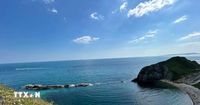Stretching more than 11,000 kilometers, the coastline of the United Kingdom stands as one of nature’s most dramatic masterpieces—a ribbon of majestic cliffs, golden sandy beaches, and pristine, narrow bays that has captivated generations. On August 21, 2025, the allure of the British shore remains as powerful as ever, drawing millions of visitors each year to explore its wild beauty and storied landmarks, according to TTXVN and VietnamPlus.
What is it about these shores that calls so many to their edge? Perhaps it’s the sheer diversity of landscapes, or maybe the sense of history that lingers in the salty air. From the windswept cliffs of Cornwall to the pebbled beaches of Brighton, the UK’s coast offers a tapestry of experiences that’s as varied as the weather itself.
One of the most iconic stretches can be found near Tintagel Castle in North Cornwall. Perched atop rugged cliffs, Tintagel is steeped in legend—some say it’s the birthplace of King Arthur. The nearby bay, with its dramatic coastline and crashing waves, is a magnet for those seeking both adventure and a brush with myth. According to TTXVN, the area around Tintagel Castle is a favorite for photographers and history buffs alike, offering views that are nothing short of breathtaking.
Head east and you’ll find Hastings, a town forever etched into English lore thanks to the famous 1066 battle. But these days, it’s the beach that steals the show. With its fine sand and vibrant summer atmosphere, Hastings beach becomes a hive of activity during the warmer months. Families sprawl across the sand, children dart in and out of the surf, and the promenade buzzes with life. As TTXVN notes, "Hastings beach with fine sand and vibrant summer scenery" is a highlight for visitors looking to soak up the sun and the town’s unique charm.
For those who prefer their beaches a little wilder, Brighton offers a different kind of magic. Its shoreline, composed of smooth, poetic pebbles, has long been a gathering place for artists, musicians, and free spirits. The pebbled expanse and the iconic Brighton Pier set against the open sea create a scene that’s both nostalgic and ever-changing. According to VietnamPlus, Brighton’s "wild beach with poetic pebbles" is emblematic of the town’s creative, laid-back spirit.
But perhaps nowhere is the drama of England’s coast more apparent than at Seven Sisters in East Sussex. Here, a series of gleaming white chalk cliffs rise sharply from the sea, forming an undulating silhouette that’s instantly recognizable. These cliffs have become a symbol of natural beauty and resilience, standing watch over the Channel for millennia. The Seven Sisters, as described by TTXVN, are "famous white chalk cliffs" that have inspired countless artists, writers, and filmmakers.
Traveling west to Dorset, the coastline takes on a prehistoric character. The Jurassic Coast, a UNESCO World Heritage Site, is home to Durdle Door, a natural stone arch that has become one of the most photographed landmarks in the UK. This striking formation, carved by time and tide, serves as a gateway between land and sea. Nearby, Man O’War Bay offers a crescent of sand and turquoise water that feels almost Mediterranean on a sunny day. According to VietnamPlus, these sites are "symbols of the Jurassic Coast in Dorset," attracting visitors who marvel at their ancient origins and enduring beauty.
Of course, no tour of the British coastline would be complete without mentioning Bournemouth. Each summer, thousands flock to its expansive beach, eager to bask in the sun and plunge into the cool waters. The town’s lively atmosphere, combined with its golden sands, makes it a perennial favorite for families and holidaymakers. As TTXVN reports, "Bournemouth beach attracts thousands of visitors during the summer," underscoring its status as a top destination.
But the appeal of the UK’s coast isn’t limited to its natural wonders. It’s also a place where history and culture are woven into the landscape. In Edinburgh, for example, the historic St Giles Cathedral stands proudly on the Royal Mile, its 900-year history making it a must-see for anyone visiting the Scottish capital. According to VietnamPlus, St Giles is "an unmissable destination in Edinburgh," offering a glimpse into the nation’s rich spiritual and architectural heritage.
What unites these diverse locations is the sense of discovery they inspire. Whether you’re clambering over rocks in Cornwall, strolling the promenade in Brighton, or gazing out over the cliffs at Seven Sisters, there’s always something new to find—a hidden cove, a secret path, a story whispered by the wind. The coastline is more than just a geographical feature; it’s a living, breathing testament to the passage of time and the enduring power of nature.
It’s no wonder, then, that the UK’s shores continue to enchant visitors from around the globe. According to both TTXVN and VietnamPlus, millions make the pilgrimage each year, drawn by the promise of adventure, relaxation, and a chance to connect with something timeless. The economic impact of this steady stream of tourists is significant, supporting local businesses, hotels, and restaurants up and down the coast. But beyond the numbers, it’s the personal experiences—the memories made, the friendships forged, the sense of awe—that truly define the value of these coastal treasures.
In recent years, there’s been a growing awareness of the need to protect and preserve these fragile environments. Erosion, pollution, and climate change all pose threats to the coastline’s future. Conservation efforts, led by local communities and national organizations alike, aim to ensure that future generations will be able to enjoy the same breathtaking views and unspoiled landscapes that have inspired so many. As visitors flock to the beaches and bays, there’s a gentle reminder to tread lightly, to respect the natural world, and to leave only footprints behind.
So, whether you’re a seasoned traveler or a first-time visitor, the coastline of the United Kingdom awaits—ready to surprise, to inspire, and to remind us all of the simple, enduring beauty that lies where land meets sea.

